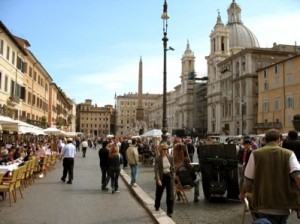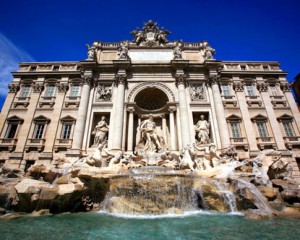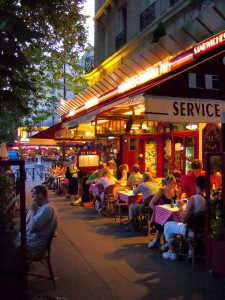This article is written by Cyrus Dadachanji, an avid food journalist, storyteller, non-fiction film and TV scriptwriter, researcher, advertising copywriter and poet, based in Mumbai
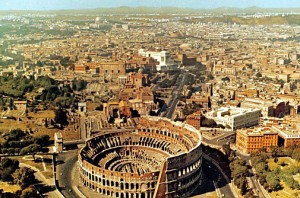
Rome is probably the only city in the world that’s so steeped in history, that it’s more proud of its ruins than of the structures still erect! Truly, a city you could easily lose your heart to!
Welcome to the Capital of what was one of the greatest empires in the world, and today is the Capital of Christendom. Welcome to Rome. The only city in the world that actually has a city within a city. Rome boasts of a rich and varied heritage. A legacy of power and opulence that oozes from every pore of the city. Where every crumbling brick has its own tale to tell. Tales of treachery, deceit, power-broking, hedonism or love. Rome is the city of faith and love alike. Where God and Cupid, seemingly inhabit every avenue, every Church and every street corner. For only in Rome are history and passion so intricately intertwined that one would be nothing without the other.
Rome is an art lover’s idea of Paradise. The city is teeming with historical monuments, paintings, sculptures, temples, basilicas and architecture that’s so rich in its diversity, that it would probably take a person a few months, if not longer to appreciate it all. However, Rome’s real attraction lies in the remnants of its ancient history and the only way to truly appreciate the grandeur of the city 2, 000 years ago, is to walk around it. And as you do, Rome will surely take your breath away, every time you round a corner.
“Rome is a city that has been built many times upon itself, layer upon layer.”
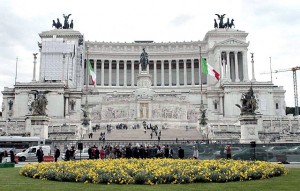 Let’s begin our stroll around Rome at the Piazza Venezia, which is almost at the centre of the city. The Piazza is the site of a giant marble monument built to honour unified Italy’s first king, Victor Emmanuel II. This relatively modern monument, with its towering Greek columns, just gives you an idea of the scale of construction, when the Empire was in its heyday. Walk around the monuments, up a majestically sweeping flight of steps, designed by Michaelangelo, to the ancient seat of power, Capitol Square on Capitoline Hill. The Palazzo Senatario across the Square is an ornate palace that’s still the ceremonial seat of Rome’s City Hall. But it is not as simple as it seems. Rome is a city that has built been many times upon itself, layer upon layer. Churches replacing ancient Roman temples. Monuments to one conqueror obliterating his predecessors’. And so on Capitoline Hill too, the Palazzo Senatario s actually built on the ancient Tabularium, where Rome’s archives were once stored. Ring out the old, ring in the new.
Let’s begin our stroll around Rome at the Piazza Venezia, which is almost at the centre of the city. The Piazza is the site of a giant marble monument built to honour unified Italy’s first king, Victor Emmanuel II. This relatively modern monument, with its towering Greek columns, just gives you an idea of the scale of construction, when the Empire was in its heyday. Walk around the monuments, up a majestically sweeping flight of steps, designed by Michaelangelo, to the ancient seat of power, Capitol Square on Capitoline Hill. The Palazzo Senatario across the Square is an ornate palace that’s still the ceremonial seat of Rome’s City Hall. But it is not as simple as it seems. Rome is a city that has built been many times upon itself, layer upon layer. Churches replacing ancient Roman temples. Monuments to one conqueror obliterating his predecessors’. And so on Capitoline Hill too, the Palazzo Senatario s actually built on the ancient Tabularium, where Rome’s archives were once stored. Ring out the old, ring in the new.
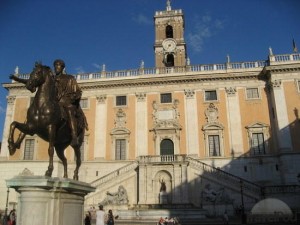 Step into the Capitoline Museum across the Square to see a wonderful statue of Marcus Aurelius, Rome’s finest military strategist on horseback. The Museum also has a 2500 year old bronze statue of a wolf which supposedly reared Romulus after whom Rome was named along with various busts of Ceasers over the centuries and some impressive mosaic work retrieved from Hadrian’s Villa among its other art treasures. In the courtyard of the Palazzo de Conservatori, opposite the Museum, lie the remnants of what was once a giant statue of Emperor Constantine, looking onto the Roman Forum. The head of the statue alone is eight and a half feet tall! The various parts of the statue are arranged around the courtyard and make a perfect photo opportunity.
Step into the Capitoline Museum across the Square to see a wonderful statue of Marcus Aurelius, Rome’s finest military strategist on horseback. The Museum also has a 2500 year old bronze statue of a wolf which supposedly reared Romulus after whom Rome was named along with various busts of Ceasers over the centuries and some impressive mosaic work retrieved from Hadrian’s Villa among its other art treasures. In the courtyard of the Palazzo de Conservatori, opposite the Museum, lie the remnants of what was once a giant statue of Emperor Constantine, looking onto the Roman Forum. The head of the statue alone is eight and a half feet tall! The various parts of the statue are arranged around the courtyard and make a perfect photo opportunity.
In the valley below the Capitol Hill lies Rome’s most revered ruins after the Colosseum, The Roman Forum. The Forum was the seat of Government, Commerce and Religion, drawing all of Rome to its majestic halls and temples over two thousand years ago.As you walk around the Forum, the sheer grandeur of Rome as it was begins to dawn on you. What were once giant meeting halls and temples are today reduced to rubble, thanks to age, neglect or sheer vandalism in many cases. Two thousand years ago, the processions of Roman emperors passed by the Temple of Antonio and Faustina, Marcus Aurelius’s foster parents, as crowds cheered by the thousand.
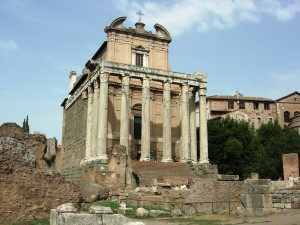 Temple of Antonio and Faustina
Temple of Antonio and Faustina
Rome’s prosperity can be judged from the ruins of Basilica Amelia, an ancient convention centre built in 179 BC. Note the green stains on the wall caused by the destruction of Copper coins, when the Goths attacked Rome and pillaged the city. The Curia, in the Forum is where the senate met and discussed matters of state, often aided by the predictions of seers and astrologers. The Forum also has its fair share of arches and temples celebrating conquests great and small as well as glorifying a hedonistic lifestyle. Any tour of the Forum would be incomplete without a mention of the Temple of Vesta, where Vestal Virgins once tended an eternal flame and if it went out, the lax virgin would pay for it with her life. Strange, how some things never seem to change…
“Each edifice is grander and more opulent than the last. And the Colosseum is the perfect example of the Roman penchant for imposing constructions.”
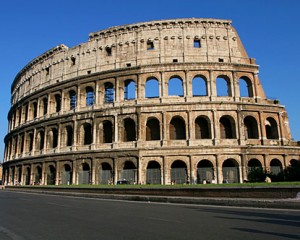 Walk around Rome and it would seem as though the word small didn’t exist in the ancient Roman’s dictionary. Each edifice is grander and more opulent than the last. And the Colosseum is the perfect example of the Roman penchant for imposing constructions. Constructed in 80 A.D., the Colosseum must have been the largest open-air amphitheatre in the world, in its day. It was faced with marble and had a huge stone arena with three tires of shaded viewing galleries capable of seating upto 50, 000 spectators! And if the construction seems grand, the programmes held here would put most of our modern day spectacles into the shade. The inaugural games lasted for 100 days, with races and gladiators fighting each other, when they weren’t fighting wild beasts. It is reported that over 5000 wild animals were killed on the first day of the games! Today, the floor of the Colosseum is no more and one can see a maze of cubicles and cells, where the wild beasts and gladiators were kept, before they were brought up to meet their respective destinies!
Walk around Rome and it would seem as though the word small didn’t exist in the ancient Roman’s dictionary. Each edifice is grander and more opulent than the last. And the Colosseum is the perfect example of the Roman penchant for imposing constructions. Constructed in 80 A.D., the Colosseum must have been the largest open-air amphitheatre in the world, in its day. It was faced with marble and had a huge stone arena with three tires of shaded viewing galleries capable of seating upto 50, 000 spectators! And if the construction seems grand, the programmes held here would put most of our modern day spectacles into the shade. The inaugural games lasted for 100 days, with races and gladiators fighting each other, when they weren’t fighting wild beasts. It is reported that over 5000 wild animals were killed on the first day of the games! Today, the floor of the Colosseum is no more and one can see a maze of cubicles and cells, where the wild beasts and gladiators were kept, before they were brought up to meet their respective destinies!
Average Rating: 5 out of 5 based on 168 user reviews.
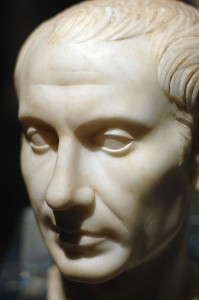 Marble bust of Julius Caesar, first century C.E.; recently discovered on the Island of Pantelleria
Marble bust of Julius Caesar, first century C.E.; recently discovered on the Island of Pantelleria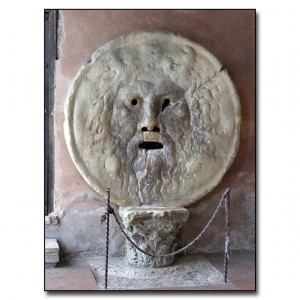 Bocca della Verità or ‘Mouth of Truth’
Bocca della Verità or ‘Mouth of Truth’